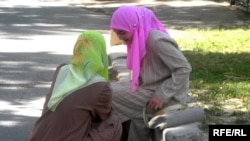In an official meeting with clerics and imams last week, the country’s Council of Islamic Clerics suggested that "foreign-made" hijabs are unsuitable for women in Tajikistan.
Instead, the clerics have encouraged Tajik women to switch to the national costume, which consists of a dress reaching below the knee, worn with trousers. The color and length of the national costume vary depending on women’s individual tastes. A head scarf is considered optional.
Tajikistan, a predominately Muslim country, has greater ties to Islamic heritage and traditions than most other Central Asian countries, even though the Tajik government has made great efforts to secularize the country since gaining independence in 1991.
Cleric Qobiljon Boev, the head of the fatwa department at the council, says the clerics believe the imported hijabs "do not meet Islamic standards.” He said the hijabs "seem to be too tight.”
“There were many clerics and senior imams in the meeting, including the grand mufti of the country,” Boev says. “And they suggested that Tajik girls should wear our national costume. Those [imported] hijabs are not compatible with real Islamic standards, and we – as representatives of an Islamic center, the Council of Islamic Clerics – oppose those hijabs that don’t meet Islamic requirements.”
Hijabs – imported mostly from Arab countries, as well as Turkey and Iran – are widely available in Tajik markets and have become a hot topic in Tajik society since the country’s Education Ministry banned head scarves in schools and universities last year.
Some students left university, some unsuccessfully sued the ministry, while many other hijab-wearing girls decided to remove their head scarves while inside school buildings.
Widening Campaign?
It appears that the government may now be expanding its campaign against the hijab.
Mehri, who works in a private shop in the capital, Dushanbe, says local officials recently ordered all female shopkeepers in the city center not to appear at work wearing hijabs.
"They called a meeting and told the girls to take off their head scarves,” Mehri says. “I didn’t go anywhere to complain. Who can I complain to? To the police?”
Many Tajiks say the government is engaged in a “losing battle” against the hijab and that the number of women and girls who wear head scarves has not decreased since the ministry’s ban.
Clerics and imams, including members of the Council of Islamic Clerics, have been actively involved in the hijab debate and have always advocated women’s religious freedom. So it was highly unusual for clerics to encourage the national costume as a “more appropriate” equivalent to the hijab.
Government Pressure
Many Tajiks say the council has come under government pressure to join its campaign against the hijab.
Abdullo Rahnamo, a Dushanbe-based expert on religious affairs, says that despite being an independent religious organization, the council has always been “close to the government” and “supported government policies.”
“Now, clerics in the council have found themselves in an awkward position,” Rahnamo says. “They don’t want to damage their good relationship with the government by refusing to denounce the hijab. At the same time, the clerics don’t know how to go against their prime mission, which is promoting Islamic values, including the Islamic hijab, and they end up giving all kinds of peculiar explanations.”
Public opinion over the hijab is sharply divided in Tajikistan, depending on citizen's educational or social backgrounds. However, many who don’t wear the hijab themselves say women should be given the freedom to choose what they wear.
Faizullo Faiziev, a school director and a Democratic Party activist in the northern town of Khujand, says, “All these hijab debates should be solved one way or another, and it should not be dragged into politics because we have many other important issues to talk and think about.”
RFE/RL’s Tajik Service contributed to this report.












